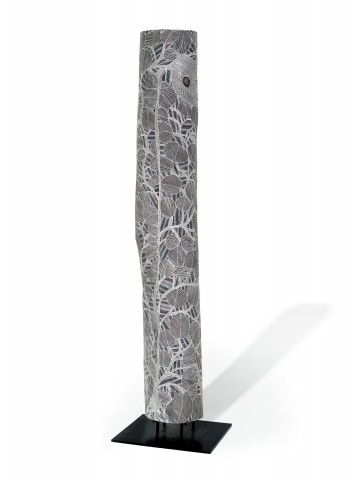GURRIMALA (LARRAKITJ), 2015
MALALUBA GUMANA
natural earth pigments on hollow log
193.0 cm height
Buku-Larrŋgay Mulka Centre, Yirrkala, Northern Territory (cat. 4801X)
Chapman & Bailey Gallery, Melbourne
Private collection, Melbourne, acquired from the above in 2020
Deutscher and Hackett would like to thank Will Stubbs from Buku-Larrŋgay Mulka Centre for his assistance in cataloguing this work.
This work is accompanied by a certificate of authenticity from Buku–Larrŋgay Mulka Centre which states:
‘This work represents Garrimala, a billabong near the artist’s residence, the Dhaḻwaŋu clan homeland at Gäṉgaṉ. It is a sacred site for the artists’ mother’s Gälpu clan.
But this imagery really refers to perhaps the oldest continuous human religious iconographical practice- the story of the Rainbow Serpent. Estimates vary from 40,000-6,000 years on the depictions of the Rainbow Serpent in West Arnhem rock shelters.
Wititj is the all powerful rainbow serpent (olive python) that travelled through Gälpu clan lands and on further, during the days of early times called Waŋarr. Djaykuŋ the Javanese filesnake is a companion and possibly alternate incarnation of Wititj, living in amongst the Dhatam, or waterlillies, causing ripples and rainbows (Djari) on the surface of the water (one reference in the cross hatch).
The story of Wititj is of storm and monsoon, in the ancestral past. It has particular reference to the mating of Wititj during the beginning of the wet season when the Djarrwa (square shaped thundercloud) begin forming and the lightning starts striking.
The Galpu clan miny’tji (sacred clan design behind the lillies) represents Djari (rainbows) and the power of the lightning within them. It also refers to the power of the storm created by Wititj, the diagonal lines representing trees that have been knocked down as Wititj moves from place to place. The ribs of the snake also form the basis of the sacred design here.
The sun shining against the scales of the snake form a prism of light like a rainbow. The arc which a snake in motion travels through holds to a rainbow shape but causes the oily shimmer to refract the colours of the rainbow. The power of the lightning is made manifest when they strike their tongue. The thunder being the sound they make as they move along the ground. The morning after a major cyclone there are swathes of stringybark bent over in snake trails through the bush in just the same way a normal scale snake leaves bent over grass traceable by trained trackers. After Cyclone Monica there was a path cleared through the stringybark forest almost from Maningrida to Jabiru.
In mortuary ceremony for Gälpu, the slithering line of dancers take on the form of Wititj and coil in the sand searching for their place. As the spirit comes to rest it adopts the metaphor of a python settling its head into the fork in the tree, known as Galmak, the final resting place of Wititj. Other references are the bunches of leaves dancers hold in their hands wet and shining in the sun, perhaps like a rainbow. This pattern is the fury of the tempest seen through the relief of the emerging survivor as the storm moves on sucking the cloud with it allowing the sun to shine.
The dots within the circle represent the water lily seed pod.’
